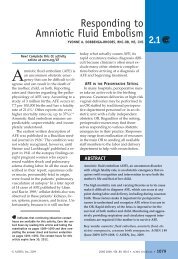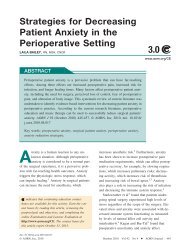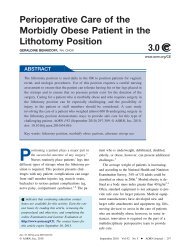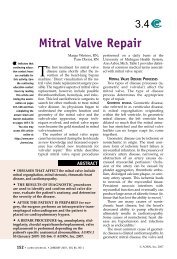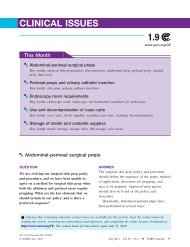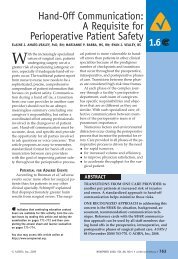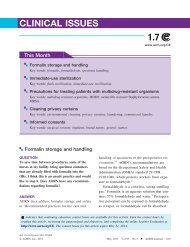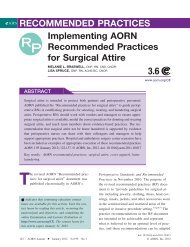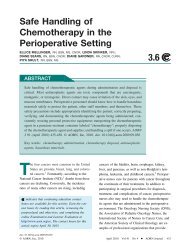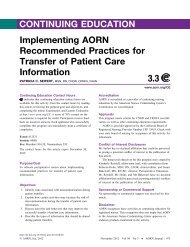Cerebral Aneurysm—Treatment and Perioperative Nursing ... - AORN
Cerebral Aneurysm—Treatment and Perioperative Nursing ... - AORN
Cerebral Aneurysm—Treatment and Perioperative Nursing ... - AORN
You also want an ePaper? Increase the reach of your titles
YUMPU automatically turns print PDFs into web optimized ePapers that Google loves.
JUNE 2007, VOL 85, NO 6Examinationc. genetic factors.d. trauma.5. Aneurysms that have been completelyclipped often reoccur.a. trueb. false6. Performing an aneurysm clippingprocedure1. minimizes the necessity forperiodic follow-up angiographicstudies.2. provides controlled access to difficultanatomy.3. allows for arterial reconstructionwhen aneurysms have complicatedshapes <strong>and</strong> wide necks.a. 1b. 3c. 2 <strong>and</strong> 3d. 1, 2, <strong>and</strong> 37. The risk of bleeding or rebleedingis greatly reduced or eliminatedwhen an endovascular coil is usedbecause thea. aneurysm sac is completely removedduring the procedure.b. packed coils <strong>and</strong> subsequentthrombus formation prevent bloodfrom entering the aneurysm.c. white blood cells surround <strong>and</strong>destroy the aneurysm sac.d. the endovascular coil is securedtightly around the neck of theaneurysm.8. Which of the following nursing interventionswould be most applicablefor the nursing diagnosis “Riskfor decreased cardiac output relatedto cardiovascular function, anesthesia,<strong>and</strong> surgical intervention?”1. Assesses peripheral pulses, skinpallor, numbness, <strong>and</strong> tingling ofextremities.2. Assesses skin integrity, sensoryimpairments, <strong>and</strong> susceptibilityfor infection.3. Evaluates for signs <strong>and</strong> symptomsof skin <strong>and</strong> tissue injury.4. Evaluates postoperative vascularfunction.5. Observes for signs <strong>and</strong> symptomsof hypovolemia in postoperativeperiod related to bloodloss.a. 1 <strong>and</strong> 3b. 2 <strong>and</strong> 4c. 1, 4, <strong>and</strong> 5d. 1, 2, 3, 4, <strong>and</strong> 59. If the neck of the aneurysm is toowide to hold the coils during an endovascularcoiling procedure, thesurgeon or radiologist maya. apply an aneurysm clip across theneck of the aneurysm.b. use bipolar electrocautery to cauterizethe aneurysm sac.c. place a stent across the neck of theaneurysm.d. opt to use the surgical clipping procedure.10. The postanesthesia care unit nursewatches for signs <strong>and</strong> symptoms of aretroperitoneal bleeding, which mayinclude1. abdominal pain or discomfort.2. excessive agitation.3. loss of peripheral pulses.4. low systolic blood pressure.a. 1 <strong>and</strong> 4b. 2 <strong>and</strong> 3c. 1, 3, <strong>and</strong> 4d. 1, 2, 3, <strong>and</strong> 4The behavioral objectives <strong>and</strong> examination for this program were prepared by RebeccaHolm, RN, MSN, CNOR, clinical editor, with consultation from Susan Bakewell, RN,MS, BC, director, Center for <strong>Perioperative</strong> Education.1184 • <strong>AORN</strong> JOURNAL



